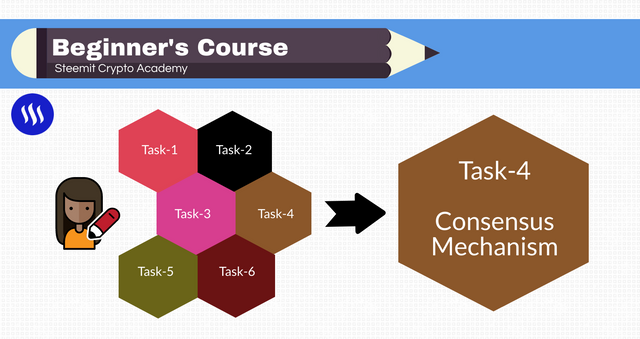Crypto Academy Season 3 Beginners' course - Homework Post for Task 4: Different types of Consensus Mechanisms || by @ahsanjawed
Hello everyone and Welcome to my Task 4 Post of Crypto Academy Season 3 Beginner Course
First and foremost, a greeting to every Steemit friend that comes to read this. This time, I bring my homework for course number 4 of the fixed beginning course, in which I will focus on answering question number 1 about consensus PoW and PoS protocols. Thanks to teacher @sapwood for the class, I hope the next one is a pleasant read for you.
Homework Task (Q.1)

💠 What is the difference between PoW and PoS?
Although both are consensus protocols (mechanisms meant to ensure that nodes agree when verifying a new block), it should be noted that not all blockchains utilize the same protocols. Today, Proof of Work (PoW) and Proof of Stake are the most well-known and widely used (PoW).
It is essential, as its name implies, that a certain project be done in PoW, "Proof of Work" for its translation into Spanish as proof of work... But what exactly does that job entail?
Normally, complicated mathematical problems, such as solving algorithms, calculations, or simply high-level problems, are required. For example, Bitcoin requires Byzantine fault tolerance, which is a high-level computer problem that entails the creation of mechanisms to prevent a catastrophic failure in a system, despite the threat of malicious factors. To achieve tolerance, the measures in place must ensure that these actors will not be able to bring the system down.
This is something so complex that it now necessitates a lot of energy in the form of powerful computer equipment to solve the problem and eventually reach a consensus that results in the generation of new blocks. Of course, all of this was accomplished for the first time thanks to Satoshi Nakamoto's algorithm, which gradually led to the blockchain becoming what it is today.
In PoS, "Proof of Stake," which can be roughly translated as "Proof of Stake," users must have cryptocurrencies in their wallets in order to be able to generate new blocks, essentially by possessing said cryptocurrency, the user's involvement in the network. All of this is done to ensure that the network reaches consensus solely through "participation." This mechanism incentivizes participation, so the more cryptocurrencies a user owns, the more likely they are to mine a new block on the blockchain and be rewarded with crypto waves.
All of this was created in order to address various issues that exist in the PoW, such as some security issues, scalability, and, of course, the significant environmental impact that the PoW has, which does not exist in PoS because this consensus protocol does not require the use of powerful computer equipment.
The main difference between PoW and PoS is in the way new blocks are mined or validated; in PoW, complex mathematical problems must be solved using extremely powerful hardware to reach consensus and validate the blocks, whereas, in PoS, complex mathematical problems must be solved using extremely powerful hardware to reach consensus and validate the blocks.
In PoS, this is made easier and more environmentally friendly because the validation of transactions and, by extension, blocks is accomplished by having only the cryptocurrency on the network, as demonstrated. For example, if I, as a DASH miner, control 5% of the existing currency, I will be able to extract the same 5%. This is done to encourage people to participate in the blockchain.
💠 Advantages & Disadvantages..?

Both systems have a strong list of advantages and disadvantages that support their use and highlight the benefits or drawbacks that come with using them; I'll break down a list of advantages and downsides for each one below.
💠 Proof of Work
💠 Advantages
It enables the blockchain to be extremely secure and virtually unhackable.
We can see that several blockchains simply copied the source code of Bitcoin because it is easy to execute algorithmically.
External attacks, counterfeiting of cryptocurrencies, or attempts to replicate transactions on the network are virtually unaffected by these systems, which depend on completing difficult mathematical operations to achieve consensus.
Maintenance of the network is simple.
💠 Disadvantages
Problems with high scalability.
Mining equipment has a high energy usage.
They tend to be centralized, and more powerful equipment is required every day, making mining power available to a smaller number of people.
They have the potential to become unjust; for example, obtaining mining rights in Bitcoin or other well-known currencies like Ethereum is now unattainable for the typical person.
Vulnerable to a 51 percent attack, in which a person with more than 50% of the mining power could change the blocks that are validated on the network and so steal assets.
💠 Proof of Stake
💠 Advantages
Very strong decentralization; unlike PoW, it is impossible to control the currency with PoS because the money must remain in a wallet at all times.
It's environmentally friendly, and it doesn't demand a lot of power to run.
To be immune to a 51 percent attack, a person must purchase more than 50 percent of coins in a market, and if someone decided that amount, the price would rise in the process, causing him to spend more than he would steal in the future. Furthermore, by the time the robbery occurs, everyone will have considered the situation and will most likely withdraw their positions.
It's a lot easier to scale.
💠 Disadvantages
Multiple transactions of the same currency can be validated in distinct chains, which is impossible in PoW and could allow a malevolent actor such as a hacker to double-spend an asset.
Difficulty in obtaining the minimal Stake; for the typical individual, this can be quite difficult, and only the wealthy prosper.
The blocks are more vulnerable since the path to consensus can be disrupted (of course, I speak in comparison to the PoW, and in the same way for the PoS to violate it is very difficult).
💠 Which is better to scale capacity?
💠 Examples:
Because the most common and simple way to make a system scalable is to make the multiple databases never depend on each other, it becomes easier to create scalability according to the consensus protocols of each one in the PoS. Yes, in the PoW, this is not normally viable because if we did something like that, putting different transaction models in place, some would be easier to violate than others because they would not always rely on the same power but different supported sources by the mining equipment, making it much more complicated.
Because the security of the PoS is not tied to the consensus process while validating the block, as it is in the PoW, but rather to the safeguarding of assets in a wallet, models that facilitate different transactions in different databases can be used. data, allowing the network to be scaled more readily.
💠 To compare…
From PoW to Bitcoin, we have a system that manages to process only 7 transactions per second, therefore a transaction on the Bitcoin network today takes roughly 10 minutes to validate.
We may also look at Ethereum as a PoW example, which is one of the quickest systems in terms of PoW but still only allowing 30 transactions per second.
We have the previously called DASH as an example of a cryptocurrency that implements the PoS consensus, which, for example, takes only 5 minutes to validate a transaction, which is twice as quick as Bitcoin.
The COSMOS network, which uses the PoS protocol and is extremely scalable, making transactions of its "ATOM" token virtually instantaneous.
💠 conclusion
Both the PoW and the PoS consensus procedures are used to validate the blocks that make up the blockchain. To ensure that all of this is always in operation, incentives are given to the entities that keep these protocols in operation, each with its own set of pros and cons, as they have been demonstrated over time as a couple of systems from which we can still expect a lot, and I am confident that we will continue to see their work in the future.

Cc:
@steemitblog
@steemcurator01
@steemcurator02
#academy-intro04 #cryptoacademy #steemexclusive #pakistan #crypto #steemit #promo-steem



Very informative post bro
Hello @ahsanjawed , I’m glad you participated in the 4th Task of the Beginner’s class at the Steemit Crypto Academy. Your grades in this task are as follows:
Recommendation / Feedback:
Your content is exceptional. Your knowledge of cryptocurrency and consensus algorithm is proven in this work.
Your presentation is good and markdowns were properly placed.
Well done on your research on PoW and PoS, I'm impressed by your submission.
Thank you for submitting your homework task 4. We hope to see the rest of your submissions.
@steemcurator02
@reminiscence01 Did i get curate according to your rating from @steemcurator02 ..??
Because it is too low according to your rating as you see in my last post i get 7.5 rating from you and get curate of $16.5.
Kindly please take a look as you resteem my post too. And appreciate it.
@steemcurator01
@sapwood
please look into my matter no-body is responding..??